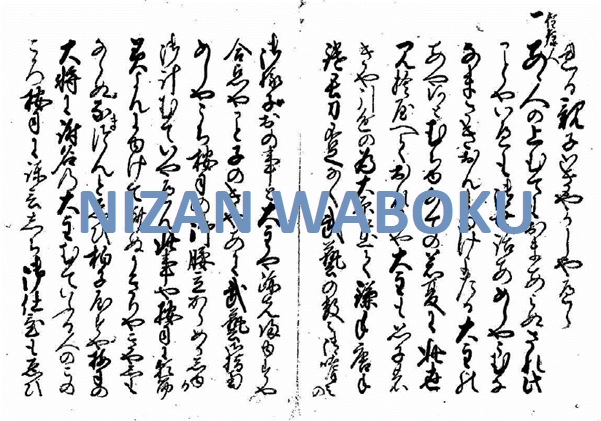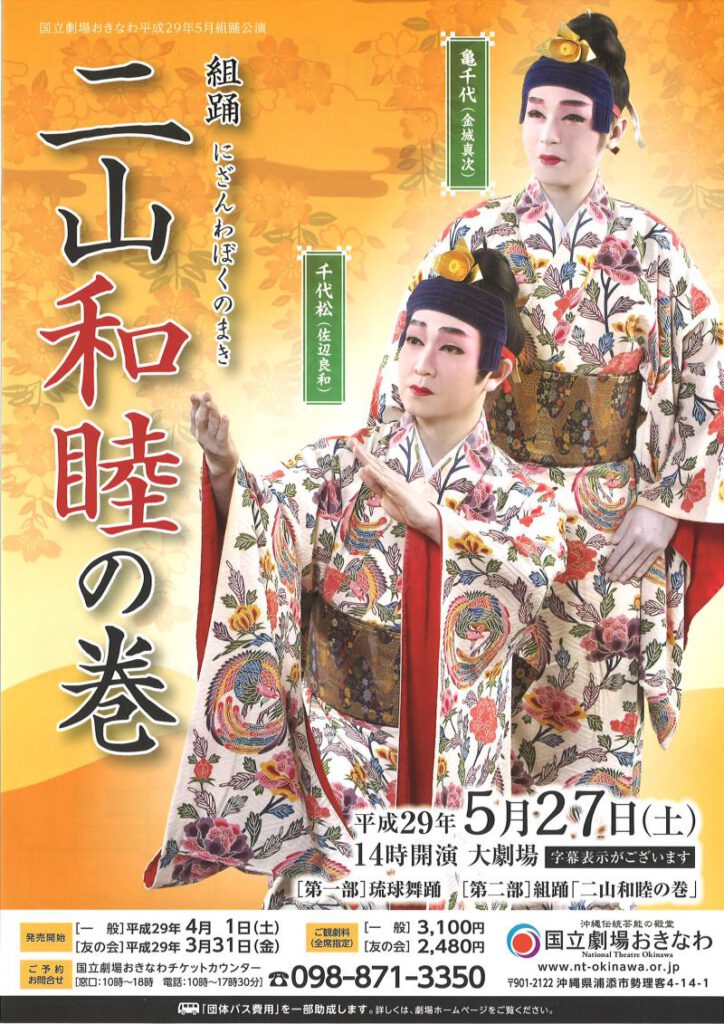As mentioned previously, in 2021, a list of “100 Footprints of Modern Karate” were published in the Okinawa Times. Of course, “Modern Karate” here refers to the period since the establishment of Okinawa Prefecture in 1879. In this list, footprint No. 2 refers to the 12th month of 1891, the date of the written notation of karate 唐手 found in the theater play called Nizan Waboku as described in the “Kumi-odori Shū” (Collection of Kumi-odori Plays), a work from the possession of the Nakijin family branch of the royal family (Nakijin Udun).
This Nizan Waboku is basically unheard of in karate circles, and not one single entry is found in a Google search. Therefore, lets take a look at the Nizan Waboku and its entry on karate.
The context of the Nizan Waboku
The king of Ryūkyū welcomed the investiture delegation from China and received the imperial edict of enfeoffment. The ship carrying the investiture envoys was called a coronation ship (kansen) or otherwise a royal coronation ship (okansen). The celebratory banquet held during the stay of the investiture envoys was quite popular and called okansen-odori (Royal coronation ship dances). It was a once-in-a-lifetime grand ceremony for the king. To enrich the okansen-odori for the investiture of King Shō Kei in 1719, in the previous year the royal government had appointed Tamagusuku Chōkun (1684-1734) as odori-bugyō (magistrate of dances), who compiled several plays under the name of kumi-odori. These were national dramas based on historical events of Ryūkyū as the theme and in the Ryūkyūan language. The kumi-odori were an important part of the okansen-odori, and an important performing art conducted under the auspices of the royal government. Performed by members of the samurē class (shizoku), kumi-odori were presented to the investiture envoys under royal inspection of the king. After bidding farewell to the investiture envoys returning to China, and after confirming that they had returned safely, the royal retainers also celebrated the so-called gozen-susumu (offering a king’s meal and drink). The kumi-odori called Nizan Waboku (The Reconciliation of Nanzan and Hokuzan) was prepared for the gozen-susumu (offering a king’s meal and drink) celebration in 1867, the year following the tora no okansen (Royal coronation ship of the Year of the Tiger) of 1866, which was the investiture for Shō Tai (1843-1901), last king of Ryūkyū.
The story of the Nizan Waboku
The Nizan Waboku takes place during the Era of the Three Kingdoms (sanzan-jidai, 14th c. -1429) of Ancient Ryūkyū and the outline is as follows.
About ten years have passed since Yoza Ufunushi, the general of Nanzan, went to Hokuzan and became prisoner. Chiyomatsu and Kamechiyo, the sons of Yoza Ufunushi, decide to go to Hokuzan to free their father. Knowing that their father is alive, the two visit the feudal lord Hokuzan Aji and beg for their father to be returned. After that, Hokuzan’s resourceful general Jana Ufunushi convinces feudal lord Hokuzan Aji to pardon Yoza Ufunushi, and peace (waboku) is reached in a question-and-answer dialogue between Yoza Ufunushi and Jana Ufunushi.
The story is based on the topic of loyalty and filial piety. The script is written in the Ryūkyū language using kanji and hiragana. Nizan Waboku is rarely performed, but on Saturday, May 27, 2017, it was presented at the Large Theater of the National Theatre Okinawa, accompanied by a nō chorus, uta-sanchin, koto (13-stringed zither), flute, kokyū (3 or 4-stringed bowed instrument), and drum.
Karate in the Nizan Waboku
Earlier I have mentioned that the written notation of karate 唐手 was found in an edition of the Nizan Waboku of 1891, but it is also found in an older source, namely in the document “Kumi-odori” of 1867 from the collections of the royal Shō family currently in possession of the Naha City Museum of History. The text passage containing karate in this 1867 libretto is the following. I will refer to this as Text 1.
“When you come to Ōbara, the state of affairs is such that they are skilled in numerous bugei (martial arts), and there is no shortage of kamade, karate 唐手, yari, and naginata.”
Karate 唐手 is written with the kanji literally translated as “Chinese hand” and this notation can be read either as karate or as tōde, but at this point it is undetermined which is the correct pronunciation in this case. It is the two sons Chiyomatsu and Kamechiyo who know this karate / tōde and the other martial arts (bugei). It is important to note that both kamade and karate / tōde bear the suffix ~de 手 while the military-style Japanese weapons of yari and naginata don’t.
It stands to reason that karate / tōde here refers to an empty-handed martial art, while the other martial arts mentioned are all martial arts with weaponry, namely the sickle (kamade), the Japanese spear (yari), and the Japanese glaive (naginata).
This seems to be an example of karate / tōde during the Ryūkyū Kingdom era. Did it already exists during the Era of the Three Kingdoms (sanzan-jidai, 14th c. -1429), where the story takes place? Or did it exist at the time when the Nizan Waboku was created sometime during the 18th or 19th century?
First of all, this Nizan Waboku play takes place in front of the historical settings of Era of the Three Kingdoms (sanzan-jidai, 14th c. -1429). This is much earlier than any source referring to “Tōde Sakugawa” or any note on a “Chinese martial art skill” called karate / tōde. However, the term might have been adopted since or after the establishment of the kumi-odori, that is, since 1719, and then used retrospectively. This would indicate that the term karate / tōde existed already in the 18th century.
Err, sorry: Tōde in the Nizan Waboku
We find the decisive clue in a different edition of the Nizan Waboku. There the term in question is written as tōde とう手, with tō written only in hiragana. From this we know that the correct pronunciation in case of the Nizan Waboku is tōde, and not karate. Moreover, this tōde might have referred to the empty-handed martial art considered to be seen in the example of “Tōde Sakugawa.” However, since tō in the 1867 edition is written in hiragana only, it’s meaning remains undetermined. Furthermore, the notation of tōde 唐手 as found in the later 1891 edition of the Nizan Waboku might simply made phonetical use of the characters tō 唐. In this case, the notation of tō 唐 could be an “assigned character” (ateji), i.e., a kanji used to only phonetically represent a word with little to no regard to its actual meaning.
So we need to dig further. Sure enough, in an attachement of the 1867 edition of the Nizan Waboku the term tōde is found again in a sentence relating to an incident involving the brothers Torachiyo and Toramatsu, who were the sons of the castellan of Hokuzan Castle. I will refer to this as Text 2:
“At that time, Torachiyo had tōde and Toramatsu had a sickle (kamade), while both also had an island cutter (shimakiride).”
In Text 1, we have seen that both kamade and tōde bear the suffix ~de 手 while the military-style Japanese weapons of yari and naginata don’t. In Text 2, tōde and kamade appear again, as does a new item called shimakiride (island cutter) which also bears the suffix ~de 手.
From the description it is implicit that Toramatsu held a sickle in one hand and a shimakiride (island cutter) in the other hand. Because Torachiyo also held an ‘island cutter’ in one hand, it would make no sense at all to interpret tōde as an empty-handed martial art. Rather, the suffix ~de here seems to indicate “to hold or use something as a weapon which is normally considered an everyday item.”
In short, the term tōde as found in different editions of the Nizan Waboku does not refer to a form of early karate or empty-handed martial arts. And in consequence, the Nizan Waboku cannot be counted as a historical source about a historical form of empty-handed karate.
Then, in case of Chiyomatsu and Kamechiyo in Text 1, and Torachiyo in Text 2, what did tōde refer to? Analysing the term tō とう, and while the meaning still remains undetermined, there are a few options that seem reasonable to speculate about.
- First, tō 籐, which is a rattan or a cane and might refer to any sort of stick or cudgel of any length, from short sticks to a rattan staff.
- Second, the very similar tō 藤. This tō is part of the Chinese word tengpai 藤牌 which refers to a shield and came to be pronounced as tinbē in the kobudō of Okinawa.
- Third, as tō 刀, referring to a knife, a blade, a cutlass, a single-edged sword.
According to the above, it is resonable to conclude that tōde did not refer to an empty-handed martial art, but to an everyday-object used in martial arts, known by Chiyomatsu and Kamechiyo in Text 1, and held in hand by Torachiyo in Text 2, and it might have been any sort of cudgel or shield.
Or a shield cudgel.
Wait…
Tonfā? I am not saying it is, but since tōde as used in the Nizan Waboku does not refer to an empty-handed martial art, it is possible after all.
© 2022, Andreas Quast. All rights reserved.


